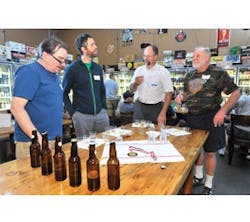About the author: Bill Gaffi, P.E., is general manager of Clean Water Services. Gaffi can be reached at [email protected] or 503.681.3600.
Water has never been more precious than now, as severe drought ravages the western U.S. and other portions of the world. It is so dry that some communities are considering “toilet to tap” systems, once considered an anathema. Rather than being driven by water emergencies, the industry has the opportunity to lead the conversation about water reuse and human consumption in communities across the country.
The first step is overcoming the “ick” factor in wastewater reuse, for which a little creative strategy and marketing is in order. Enter Clean Water Services’ home state, Oregon, a beer-lover’s paradise. Portland has the most microbreweries of any city in the world, and beer is a $2.83-million industry that helps fuel the economy.
Brewers are keenly attuned to water quality because water is their main ingredient. The historic German beer purity law, Reinheitsgebot, allows only four all-natural ingredients in the brewing process—water, hops, barley and yeast.
As Clean Water Services searched for a pilot project to show how clean any water can be made using water purification technologies, it decided beer was an ideal way to showcase the quality, safety and taste of highly purified water.
Thus, the Pure Water Brew Competition came about.
Brewing for the Gold
In August 2014, Clean Water Services teamed with Carollo Eng. and the Oregon Brew Crew, Oregon’s largest association of home brewers, to challenge home brewers to a contest featuring beer made with highly purified water drawn from a river. The organizations wanted to offer highly purified wastewater effluent, but the regulators were not ready to approve that. Instead they collected 1,000 gal of water from the Tualatin River just downstream from Clean Water Services’ treatment facilities, where the water is 30% effluent, and ran that water through a high-purity water system before offering it to home brewers. The brewers were excited to have a “blank slate” to create their best beers.
Thirteen brewers took the challenge and brewed 16 styles of beer. They were given the purified water and a small stipend to cover their costs. On Sept. 6, 2014, the beers were judged, and the winning brewer received $150, while three other winners took home prizes of $100 each. The “Best in Show” was a vox max Belgian by Ted Assur. Second place was a German pilsner by Jeremie Landers, third was a single-grain saison by Mark Marsh and fourth was a kolsch by Nick Dahl.
The four winning beers traveled to New Orleans to be sampled at the WateReuse Assn.’s One Water Innovations gala at WEFTEC.14 on Sept. 28. The gala featured food, wine and beer grown and produced sustainably with reused water.
The four winning beers were a hit at the gala, but even more important than the competition was the opportunity to demonstrate that all water is “one water,” part of a constantly renewing cycle. The competition garnered stories in local and national media.
In order to tap into the potential of reuse water as a source of clean water, it takes technology, acceptance and regulations. Public education and awareness will invite social acceptance. Perhaps the largest hurdles will be to rewrite federal and state regulations.
As an industry, it is necessary to raise public awareness of water as a reusable resource. Wastewater experts can plan for the future by using creativity to demonstrate to the public the safety of purified water. Projects like the Pure Water Brew Competition introduce this work to the public in a unique and easy-to-understand way.
Visit http://youtu.be/9Sk8TJ2sxE8 to view a video from the Pure Water Brew Competition.
Download: Here
